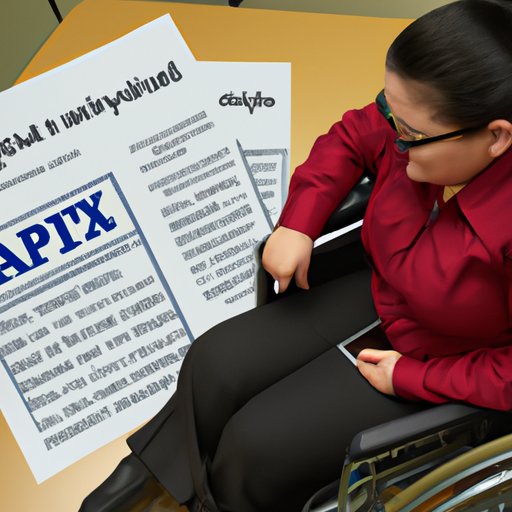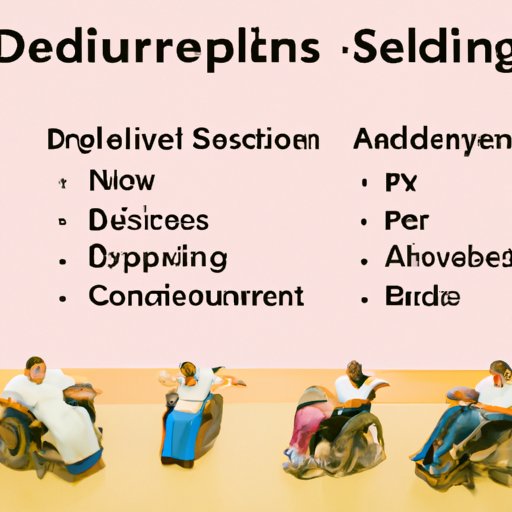(Disclaimer: The information presented may be outdated. Please evaluate before reading.)
Introduction
When an individual is unable to work due to a disability, they may be eligible to receive disability benefits from the government. These benefits provide financial assistance to help individuals who are unable to work, but the amount of money received varies depending on a variety of factors. This article will explore how much money an individual can make while on disability, as well as the rules and regulations associated with working while on disability.
Calculating Your Income on Disability: How Much Money Can You Make?
The amount of money an individual receives in disability benefits depends on several factors, including the type of disability benefits received, the individual’s living situation, and the individual’s income and assets. There are two main types of disability benefits offered by the government: Social Security Disability Insurance (SSDI) and Supplemental Security Income (SSI). SSDI is available to those who have paid into Social Security through their payroll taxes, while SSI is available to those who have limited income and resources.
In addition to these two types of disability benefits, there are other sources of income available to individuals on disability, such as workers’ compensation and private disability insurance. Additionally, some states offer Medicaid, which provides health coverage for those on disability.
It is important to understand the effects of working while on disability. In most cases, any earnings over a certain amount will reduce the amount of disability benefits received. The exact amount depends on the type of disability benefits received, so it is important to do research to determine the exact amount. Additionally, any income earned from investments or other sources must also be reported.
When calculating potential earnings, it is important to consider all sources of income, including any disability benefits received and any wages earned from working. Additionally, any other sources of income, such as investments or rental income, must be taken into consideration. It is also important to factor in any expenses associated with working, such as transportation costs or child care.
Maximizing Your Disability Benefits: What is the Maximum Earnings Limit?
The Social Security Administration (SSA) has established rules for working while on disability. These rules include a maximum earnings limit, which is the maximum amount of money an individual can earn while still receiving disability benefits. Knowing this limit can help individuals maximize their disability benefits.
The SSA’s rules state that individuals receiving SSDI cannot earn more than $1,220 per month, or $2,040 if they are blind. For SSI recipients, the limit is $771 per month, or $1,157 if they are blind. If an individual earns more than these amounts, their disability benefits will be reduced or eliminated.
There are strategies for maximizing one’s disability benefits. For example, individuals can work part-time or take advantage of work incentive programs, such as the Ticket to Work program offered by the SSA. Additionally, individuals can use the trial work period, which allows them to test their ability to work without losing their benefits.

Exploring Tax Implications for Working While on Disability
When working while on disability, it is important to be aware of the tax implications. All earnings, including wages and self-employment income, are subject to FICA and Medicare taxes. Additionally, individuals must pay federal and state income taxes, depending on their state of residence.
The Internal Revenue Service (IRS) requires individuals to report all earned income, including wages and self-employment income. This includes any income earned from investments or rental properties. Individuals must also report any disability benefits received on their taxes.
Understanding the Social Security Administration’s Rules on Working and Earning on Disability
The SSA has several rules and regulations regarding working while on disability. These include work incentives programs, such as the Ticket to Work program, which helps individuals transition back to work while still receiving disability benefits. Additionally, the SSA offers the trial work period, which allows individuals to work up to nine months without losing their benefits.
The SSA also offers exempt earnings, which are earnings that do not count towards the maximum earnings limit. Examples of exempt earnings include scholarships, fellowships, and grants. Additionally, payments received from workers’ compensation and private disability insurance policies are not counted towards the maximum earnings limit.
Navigating the Process of Applying for Disability Benefits and Working at the Same Time
It is important to research the eligibility requirements for disability benefits when applying for benefits. Additionally, individuals should familiarize themselves with the application process for both disability benefits and employment. It is also important to understand the potential financial impact of working while on disability, as any earnings may reduce the amount of benefits received.

Investigating Different Types of Employment Available to Individuals with Disabilities
When considering working while on disability, it is important to investigate different types of employment available to individuals with disabilities. Traditional employment opportunities are available to individuals with disabilities, as well as self-employment options. Additionally, there are alternative employment opportunities, such as volunteering, apprenticeships, and job training programs, that may be beneficial for individuals on disability.
Conclusion
For individuals on disability, understanding how much money they can make and the rules and regulations associated with working while on disability is essential. This article has explored the different types of disability benefits available, the effects of working while on disability, the maximum earnings limit set by the SSA, tax implications, and different types of employment available to individuals with disabilities. By researching the information presented in this article, individuals can make informed decisions about their disability benefits and their ability to work.
(Note: Is this article not meeting your expectations? Do you have knowledge or insights to share? Unlock new opportunities and expand your reach by joining our authors team. Click Registration to join us and share your expertise with our readers.)

Hello. Google Alerts brought this article my way. You do a disservice by reporting a figure five years out of date.
https://www.ssa.gov/oact/cola/sga.html